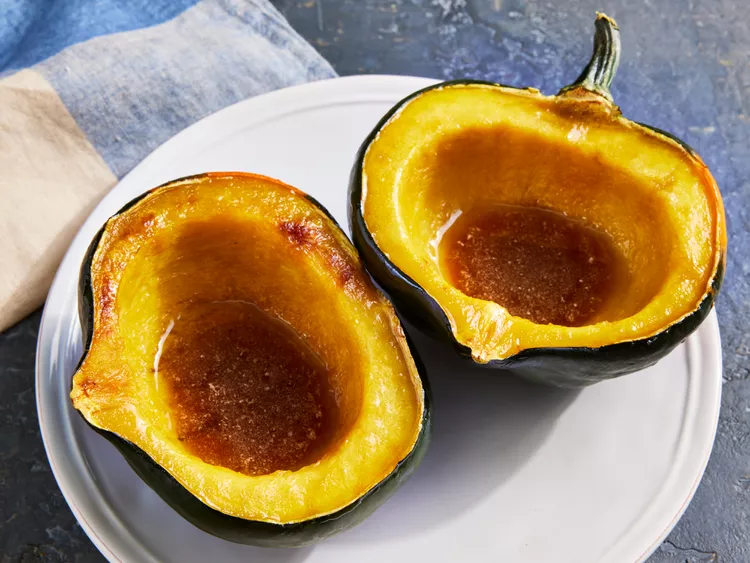Gastronomic Excellence: The Definitive Roasted Acorn Squash Protocol
Acorn squash (Cucurbita pepo) represents a sophisticated cornerstone of autumnal and winter cuisine. Its distinctive ridges and mild, nutty profile provide a versatile foundation for both classic sweet preparations and contemporary savory pairings.1 This formal guide details the methodology for achieving a perfectly roasted acorn squash, emphasizing precision and flavor balance suitable for both daily consumption and formal dining.
Nutritional Profile and Preparation Fundamentals
Acorn squash is not only lauded for its culinary adaptability but also for its robust nutritional content.2 A one-cup serving of cooked acorn squash is notable for its high concentration of essential micronutrients, particularly Potassium (approx.3 896 mg), Magnesium (approx.4 88 mg), and Vitamin C (approx. 22 mg), alongside an impressive 9 grams of dietary fiber.5 This nutrient density positions the vegetable as a healthy, complex carbohydrate alternative to starches like potatoes.
H3: Selecting the Specimen and Precision Halving
The quality of the final dish is predicated on the selection of the raw ingredient.
-
Selection: Choose specimens that are firm to the touch and heavy relative to their size. The rind should exhibit a deep, dull green color with minimal soft spots or blemishes.
-
Preparation Method: Due to the toughness of the outer shell, a high-quality, sharp chef’s knife is mandatory for safe processing.6
-
Stabilization: Trim a small slice from the stem end to create a flat, stable base for the squash on the cutting surface.7
-
Bisection: Carefully slice the squash longitudinally, from the flattened stem end to the tip.8
-
Deseeding: Employ a sturdy metal spoon to thoroughly remove all seeds and fibrous strands from the internal cavity.9
-
Methodology: The Classic Maple-Brown Sugar Glaze
The most celebrated preparation leverages the squash’s subtle sweetness through controlled caramelization. This protocol yields a tender, buttery side dish.
-
Prep Time: 10 minutes10
-
Cook Time: 45–50 minutes11
-
Temperature: 12$400^{\circ}\text{F}$ (13$200^{\circ}\text{C}$)14
| Component | Quantity (Per Half) | Function |
| Acorn Squash | 1/2 medium | Core Ingredient |
| Unsalted Butter | 1 tablespoon | Fat medium; promotes creamy texture |
| Pure Maple Syrup | 1 tablespoon | Sweetener; encourages caramelization |
| Brown Sugar | 1/2 tablespoon | Deepens flavor; enhances glaze viscosity |
| Ground Cinnamon | Pinch | Aromatic spice |
| Fine Sea Salt | Pinch | Flavor equilibrium |
H3: Roasting Protocol for Halves
-
Initial Roast (Vapor Phase): Place the cleaned squash halves cut-side down on a baking sheet lined with parchment paper.15 This orientation facilitates internal steaming, which is critical for achieving a uniformly tender texture without desiccation. Roast for 30 minutes.
-
Glaze Application (Caramelization Phase): Remove the sheet from the oven and carefully flip the squash halves to be cut-side up.
-
Filling: Place the measured butter, maple syrup, brown sugar, and a pinch each of cinnamon and salt into the cavity of each half.
-
Final Bake: Return to the oven for an additional 15–20 minutes, or until the flesh is easily pierced with a fork and the glaze has melted into a rich, bubbling syrup.
-
Service: Serve directly in the shell, basting the flesh with the pooled glaze immediately prior to presentation.
Advanced Application: Savory Herb-Encrusted Slices
For applications requiring an alternative to sweet profiles, a savory preparation featuring herbs and a par-baked cheese crust is recommended.16 This method utilizes sliced squash, reducing total cooking time and enhancing surface area for seasoning.
H3: Slicing and Savory Encrustment Protocol
-
Slice Preparation: After halving and deseeding, slice the squash into uniform 1/2-inch thick crescent pieces.17 The skin is thin and edible, providing structural integrity during roasting.18
-
Aromatic Coating: In a mixing bowl, lightly toss the squash slices with extra virgin olive oil, kosher salt, black pepper, garlic powder, and a blend of freshly chopped thyme and rosemary.
-
Roasting & Crusting: Spread the seasoned slices in a single layer on a baking sheet.19 Roast at $400^{\circ}\text{F}$ ($200^{\circ}\text{C}$) for 15 minutes.
-
Encrustment: Remove the sheet, flip the slices, and uniformly sprinkle a generous layer of finely grated Parmesan cheese over the exposed surfaces.20
-
Finishing: Return to the oven for a final 10 minutes, allowing the cheese to melt and form a golden, crispy crust.
This versatile winter squash, prepared using either the classic glazed or the contemporary savory protocol, offers an elegant and nutrient-rich addition to any seasonal menu.
